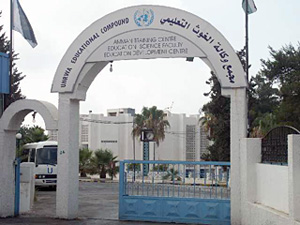Weekly Reports from Jordan
Choose Year: or Choose week
July 24-30, 2004
Larry G. Herr and Douglas R. Clark
Ellen Left Too Early
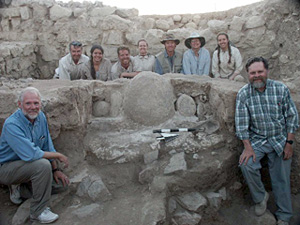 When teacher Ellen Bedell arranged to come for only the first half of the season, she knew she would miss the excitement of the last hectic days of excavation. She probably reasoned that that would not necessarily be a bad thing! And she would normally have been correct. But little did she know that she would miss the find of the excavation-in her square! Readers may remember that, on her last day with us, we ceremonially sacrificed her in front of a strange rounded stone she had nicknamed the "whale shrine." But no one knew at the time the full importance of the discovery.
When teacher Ellen Bedell arranged to come for only the first half of the season, she knew she would miss the excitement of the last hectic days of excavation. She probably reasoned that that would not necessarily be a bad thing! And she would normally have been correct. But little did she know that she would miss the find of the excavation-in her square! Readers may remember that, on her last day with us, we ceremonially sacrificed her in front of a strange rounded stone she had nicknamed the "whale shrine." But no one knew at the time the full importance of the discovery.
The Late Bronze Age (ca. 1400-1300 BC) “whale shrine” in Field B has turned out to be an unequivocal shrine or cultic niche carved out of a mudbrick wall and carefully whitewashed. Carolyn Waldron (who took Ellen’s place) and Monique Acosta discovered that the large central, domed standing stone (the “whale shrine”) was actually flanked by four other, smaller stones, two on a side. Ancient worshipers had selected rounded or oval stones and carefully set them all into a generous backing of plaster so they could not be moved. The oval stone on the far right was small, but was naturally shaped with strangely fluid abstract designs as limestone and chert-filled solution cavities. It was Picasso in the Bronze Age. When we first saw it, our imaginations soared, thinking it was intentionally created. But since then, we have found one or two other similar stones. The interesting shapes are completely natural! Archaeologists usually identify standing stones such as these with deities. Indeed, our find seems to confirm the consensus. Who were our deities? Unfortunately, there are so far no inscriptions to help us, but Il (or El, a name meaning simply “God”) was the major deity of the time and may be represented by the large central stone. Il was the father of the gods and the other stones may have suggested some of his children to ancient worshipers.
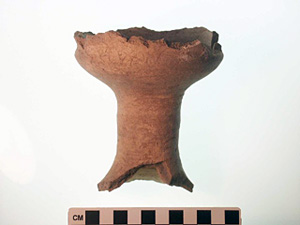 On top of the two smaller stones to the right of the central stone, almost as if placed on them as a shelf, were two typical carinated bowls (one normal size and the other almost a miniature), a lamp, a crude unfired clay figurine, and a pedestal-based chalice . The last item was normally used in religious rites. The figurine is similar to several others we found last season in the room behind the niche. Such a room behind a holy place where dedicated goods are stored is called a favissa.
On top of the two smaller stones to the right of the central stone, almost as if placed on them as a shelf, were two typical carinated bowls (one normal size and the other almost a miniature), a lamp, a crude unfired clay figurine, and a pedestal-based chalice . The last item was normally used in religious rites. The figurine is similar to several others we found last season in the room behind the niche. Such a room behind a holy place where dedicated goods are stored is called a favissa.
LATE BREAKING NEWS!!!
The Daily Star Newspaper, published by Rami Khouri in Beirut, Lebanon, is running a short story on this discovery Thursday, 5 August. If you do not receive the paper where you live, you may access the story in Thursday’s edition online: www.dailystar.com.lb.
Meanwhile, two other teams were trying to find the immediate context of the niche by discovering the floor of the room it was in and by attempting to find the other rooms of the building. Janelle Worthington and Matt Vincent went for the floor, but in spite of working two extra afternoons they did not reach it. It appears the shrine was placed well above the floor on a stepped platform. But Janelle and Matt are already well over a meter below the bottom of the niche and have clearly not found the floor. They can’t approach the niche area with speed because it is made of mudbricks and work must proceed very slowly to trace them accurately.
Together with Shawne Hansen and Cynthia Temoin, however, they have located the walls of the large room the niche was in. It measured about 5 meters by 8 meters. There were probably at least two columns holding up the room, but we will have to wait until next season when we find the floor to know if there are column or post bases.
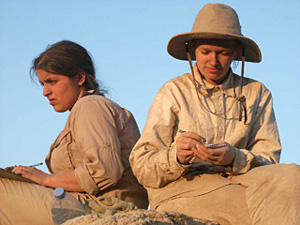 Janelle Lacey, working farther east in the next room, discovered the eastern wall of the building and, although she dug frantically for the floor of this antechamber, it still lies below. John Raab, who would normally be working with Janelle, has been laid up with sciatica for the last few days. But we keep him apprised of the discoveries every day. One consolation for this group of diggers, whose dusty faces at the end of each day reflected the intensity of their desire to find the floor, was that they have excavated to the level of the floors in the rooms to the south and were able to walk through the building and its doorways with the Late Bronze Age walls towering a meter over their heads. The building is surprisingly well preserved because later ancient builders seem to have ignored the location for several centuries.
Janelle Lacey, working farther east in the next room, discovered the eastern wall of the building and, although she dug frantically for the floor of this antechamber, it still lies below. John Raab, who would normally be working with Janelle, has been laid up with sciatica for the last few days. But we keep him apprised of the discoveries every day. One consolation for this group of diggers, whose dusty faces at the end of each day reflected the intensity of their desire to find the floor, was that they have excavated to the level of the floors in the rooms to the south and were able to walk through the building and its doorways with the Late Bronze Age walls towering a meter over their heads. The building is surprisingly well preserved because later ancient builders seem to have ignored the location for several centuries.
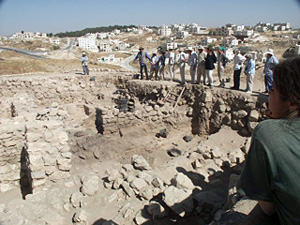 What kind of building was this? In an earlier note to a few colleagues, we announced that this was a temple. Certainly, the niche and its contents are a worthy point of focus for such a building, and there is an antechamber and a favissa, things normally associated with temples. Other senior archaeologists who have visited us in the last week, Ghazi Bisheh and Fawzi Zayadine, agreed. However, we have no indication of sacrificial activities. So far there is no courtyard with an altar. There are no burned bones. But this is also the case at other LB temples at other sites. There are also two other unique
What kind of building was this? In an earlier note to a few colleagues, we announced that this was a temple. Certainly, the niche and its contents are a worthy point of focus for such a building, and there is an antechamber and a favissa, things normally associated with temples. Other senior archaeologists who have visited us in the last week, Ghazi Bisheh and Fawzi Zayadine, agreed. However, we have no indication of sacrificial activities. So far there is no courtyard with an altar. There are no burned bones. But this is also the case at other LB temples at other sites. There are also two other unique 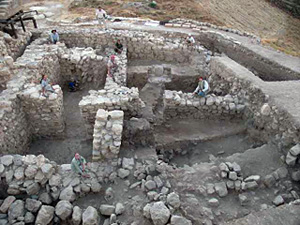 aspects of our building if it is a temple. The niche seems extremely high in the wall and would have forced worshipers to look up. Of course, that was the stance of ancient prayer, but most temple niches are lower with only a few steps leading up to them. There are also two rooms attached to the south side of the building. Nothing was found on the floors of these rooms so we don’t know their function. Could our room with the niche simply be a shrine room within a larger structure, such as a palace? If so, it takes up over 30% of the building. Or were the two southern rooms simply side rooms to the “temple”? The debate has just begun.
aspects of our building if it is a temple. The niche seems extremely high in the wall and would have forced worshipers to look up. Of course, that was the stance of ancient prayer, but most temple niches are lower with only a few steps leading up to them. There are also two rooms attached to the south side of the building. Nothing was found on the floors of these rooms so we don’t know their function. Could our room with the niche simply be a shrine room within a larger structure, such as a palace? If so, it takes up over 30% of the building. Or were the two southern rooms simply side rooms to the “temple”? The debate has just begun.
Believe it or not, we will have to cover the niche with dirt and replica mudbricks the exact size of what we excavated to preserve it for restoration. The mudbrick wall and the whitewash are simply too flimsy to last more than a few days of exposure to the weather. Next season we will complete excavation of the building and preserve it and the niche for future visitors to the site.
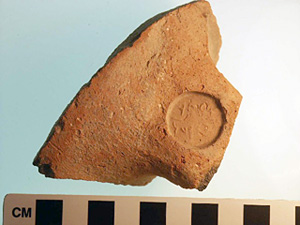 Also in Field B, while removing a balk, Shawne Hansen and Cynthia Temoin discovered a broken jar handle that had a seal impression stamped into it. After we removed the lime deposits, we could clearly see that there was writing on two lines. It’s always exciting to find an inscribed seal impression. Usually they contain names of owners. But this one was special. It had been made around 500 BC, based on the style of writing of its Aramaic script. It also contained the name of the province of Ammon when it was part of the Persian Empire along with the name of a major government official in the province. This name may have been Ilizar or something like that, but the “z” is uncertain. We have to get the object home to a dissecting microscope to be more certain. This is the fifth Ammon seal impression we have found at Umayri, the only site in the Persian province of Ammon to produce such seals so far.
Also in Field B, while removing a balk, Shawne Hansen and Cynthia Temoin discovered a broken jar handle that had a seal impression stamped into it. After we removed the lime deposits, we could clearly see that there was writing on two lines. It’s always exciting to find an inscribed seal impression. Usually they contain names of owners. But this one was special. It had been made around 500 BC, based on the style of writing of its Aramaic script. It also contained the name of the province of Ammon when it was part of the Persian Empire along with the name of a major government official in the province. This name may have been Ilizar or something like that, but the “z” is uncertain. We have to get the object home to a dissecting microscope to be more certain. This is the fifth Ammon seal impression we have found at Umayri, the only site in the Persian province of Ammon to produce such seals so far.
Closedown
It’s one of the “facts” of excavation that the last week is the most exciting. It’s precisely the time archaeologists don’t want exciting discoveries, but they almost never fail to occur! Fortunately, for us, the other fields of excavation performed their closedown procedures less frantically than Field B.
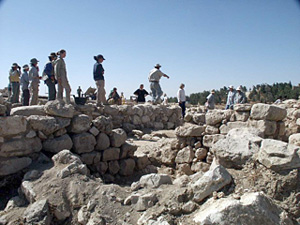 All squares in Field A, however, had interesting discoveries. The season’s goal of this field had been to get down to Iron 1 levels (1200-1000 BC) by the end of the season. Brenda Adams and Andrew Curtis discovered Iron 1 deposits under their Iron 2/Persian remains (600-400 BC), but will have to excavate the earliest Iron 2 surfaces next season. Christine Shaw and Ralph Kneller had found Iron 1 walls and floors already in their main square and, this week, removed a balk, discovering a reconstructable late Iron 1 pithos. Virginia Gonthier, who has been cleaning bones this season after a few
All squares in Field A, however, had interesting discoveries. The season’s goal of this field had been to get down to Iron 1 levels (1200-1000 BC) by the end of the season. Brenda Adams and Andrew Curtis discovered Iron 1 deposits under their Iron 2/Persian remains (600-400 BC), but will have to excavate the earliest Iron 2 surfaces next season. Christine Shaw and Ralph Kneller had found Iron 1 walls and floors already in their main square and, this week, removed a balk, discovering a reconstructable late Iron 1 pithos. Virginia Gonthier, who has been cleaning bones this season after a few 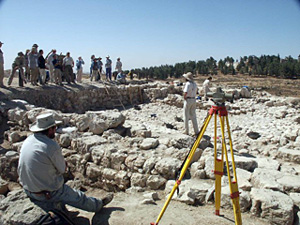 days in the field but who normally reconstructs the pottery in the huge Walla Walla lab, tells us that there are 99 pithoi under reconstruction at the lab. If correct, this makes number 100! John McDowell and Juliette Syamando took out a late Iron 2 wall to discover the Iron 1 wall beneath and now can point to an excellently preserved room with a doorway. It joins to another Iron 1 room to the west. We’re beginning to produce a much more coherent glimpse of life at our site during the time of the biblical judges.
days in the field but who normally reconstructs the pottery in the huge Walla Walla lab, tells us that there are 99 pithoi under reconstruction at the lab. If correct, this makes number 100! John McDowell and Juliette Syamando took out a late Iron 2 wall to discover the Iron 1 wall beneath and now can point to an excellently preserved room with a doorway. It joins to another Iron 1 room to the west. We’re beginning to produce a much more coherent glimpse of life at our site during the time of the biblical judges.
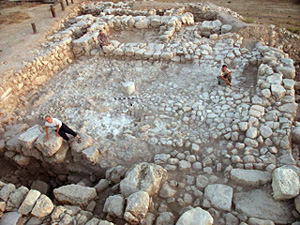 The people in Field H (Dave Berge, Don Mook, Larry Murrin, Andrea DeGagne, and Kristy Huber) have managed to clear the large cobbled courtyard of the early Iron 2 period (10 th to 9 th centuries). We had been dating it to late Iron 1, but new discoveries suggest it was slightly later than we had thought . We even managed to find more pieces of model shrines and statues in the process.
The people in Field H (Dave Berge, Don Mook, Larry Murrin, Andrea DeGagne, and Kristy Huber) have managed to clear the large cobbled courtyard of the early Iron 2 period (10 th to 9 th centuries). We had been dating it to late Iron 1, but new discoveries suggest it was slightly later than we had thought . We even managed to find more pieces of model shrines and statues in the process.
Work this week in Field L managed to show that many of the walls we had thought were late Iron 2 (6 th century BC) really seem to be an earlier phase of 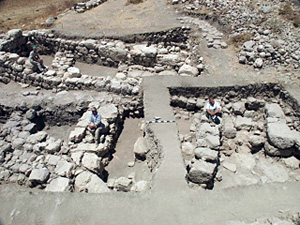 Hellenistic (3 rd to 2 nd centuries BC). In fact, tightly wedged beneath one of the stones of a “secure” late Iron 2 wall was a clear Hellenistic pithos rim! If nothing else, archaeology is sure to keep us humble!
Hellenistic (3 rd to 2 nd centuries BC). In fact, tightly wedged beneath one of the stones of a “secure” late Iron 2 wall was a clear Hellenistic pithos rim! If nothing else, archaeology is sure to keep us humble!
Everyone has started drawing balks and cleaning for final photos. Workers in Field H were beginning to wonder what was happening to them as they began to clean their spacious cobbled courtyard for the third time. But the final photo from the 5-meter ladder was spectacular! In archaeology, cleanliness is next to godliness! We 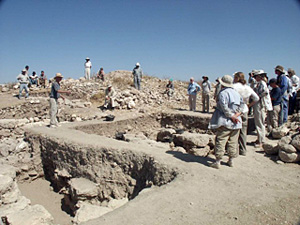 have three times during the day when final photos can be done so as to avoid distorting shadows. In the morning before the sun comes up, at noon when the sun is high and casts few shadows, and in the evening after sundown before it gets too dark . Everything must be spick and span for the final photos. But the boring work of brushing for several hours dulls one’s sense of clarity.
have three times during the day when final photos can be done so as to avoid distorting shadows. In the morning before the sun comes up, at noon when the sun is high and casts few shadows, and in the evening after sundown before it gets too dark . Everything must be spick and span for the final photos. But the boring work of brushing for several hours dulls one’s sense of clarity.
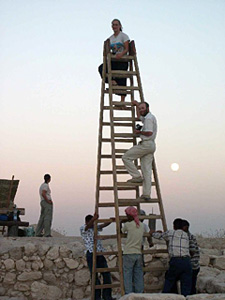 Closedown is always a stressful time with pressures to finish notebooks, draw all the finds, schedule final photos, draw top plans, and take inventories of all the tools of the various departments of the dig, such as pottery registry, object registry, photography, computers, kitchen equipment, handyman equipment, etc., etc. We have to process every potsherd and spindle whorl, completing the object database so the report for the Department of Antiquities can be submitted by Wednesday! While some people work in the field, others take care of camp chores, even washing the pottery from other people’s squares. This is the time that tests our abilities to act as a team. So far, our group this year has functioned extremely well!
Closedown is always a stressful time with pressures to finish notebooks, draw all the finds, schedule final photos, draw top plans, and take inventories of all the tools of the various departments of the dig, such as pottery registry, object registry, photography, computers, kitchen equipment, handyman equipment, etc., etc. We have to process every potsherd and spindle whorl, completing the object database so the report for the Department of Antiquities can be submitted by Wednesday! While some people work in the field, others take care of camp chores, even washing the pottery from other people’s squares. This is the time that tests our abilities to act as a team. So far, our group this year has functioned extremely well!
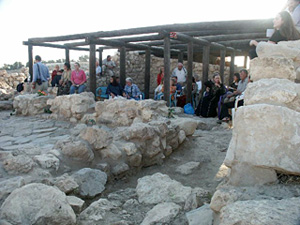 Party Time
Party Time
But Saturday night was a time to let loose. We partook of some creative nonsense and good food. In the evening we gathered at the four-room house for our “talent” show, bringing the plastic chairs donated this season by Mary Boyd.
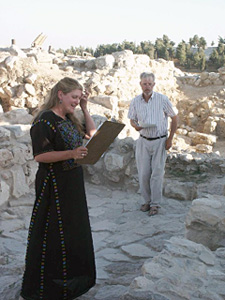 |
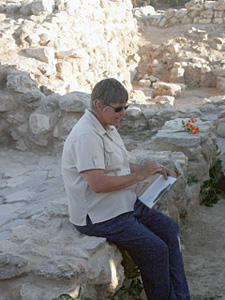 |
Actually, instead of a time to display our more “dubious” skills, it turned out to be a performance of genuine talent! Hosted by Megan Owens, it featured adaptations of famous songs, poems, and nursery rhymes to archaeological situations by Megan Owens, David Hopkins, Denise Herr, Ruth Kent, and Myken McDowell.
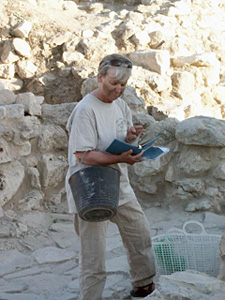 |
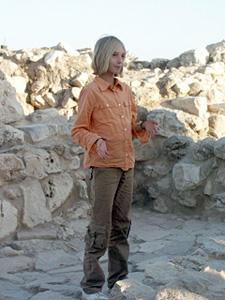 |
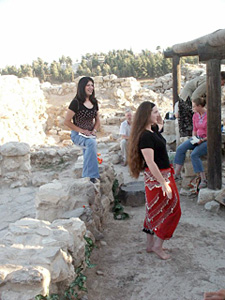 |
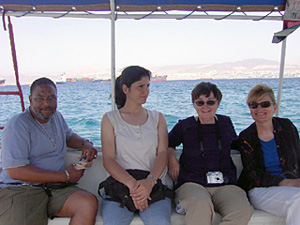 |
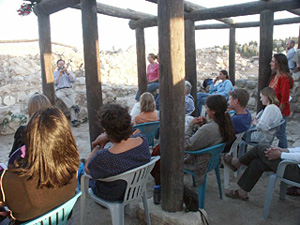 Juliette Syamando sang an Arabic song to accompany Cynthia Temoin’s belly dancing and Larry Herr performed a version of the Umayri Blues, something of a tradition from year to year.
Juliette Syamando sang an Arabic song to accompany Cynthia Temoin’s belly dancing and Larry Herr performed a version of the Umayri Blues, something of a tradition from year to year.
Mary Boyd, our textile specialist, presented the prestigious Spinderella Award to Brenda Adams and Andrew Curtis for finding the most textile-related objects. We must also mention the winners of this year’s coveted Siegfried Awards (this wouldn’t be tongue in cheek, would it?). Named after the founder of MPP, Siegfried Horn, award winners included Janelle Worthington who received an Architectural Locus Sheet for the Most Loci Worked in One Day (10)—the architectural locus sheet is in recognition of the fact that it was a truly monumental achievement.
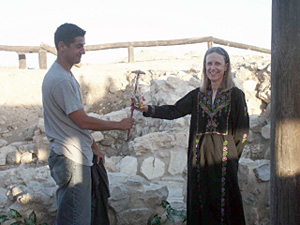 |
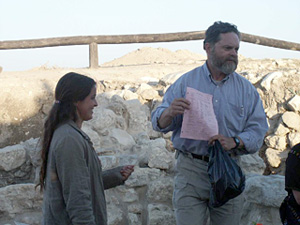 |
Janelle Lacey won a bag of 10YR 6/3 (pale brown) dirt for the Most Archaeological Phases on a Face. Typically, the zip-lock bag refused to seal and I’m sure the dirt “accidentally” spilled out. Megan Owens won a mechanical pencil with its eraser used up for the Most Bio-turbation in a Square. She carefully excavated scores of rodent holes and then proceeded to draw them on her top plans and balk drawings.
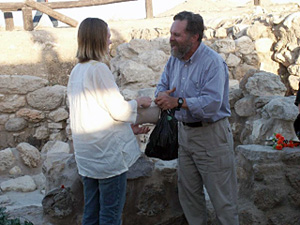 |
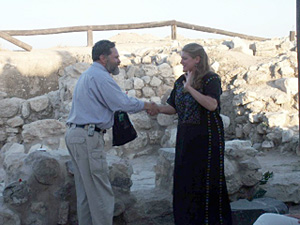 |
Andrea DeGagne and Kristy Huber shared the prize for the Most Grindstones Carefully Brushed in a Square by each accepting a small fragment of a grindstone. They had excavated a pit full of these items. Ruth Kent won a plastic bathroom pitcher for the Most TP Rolls Handled in One Day—she was the TP Czarina for the field outhouse . All recipients were utterly speechless as they humbly accepted their awards.
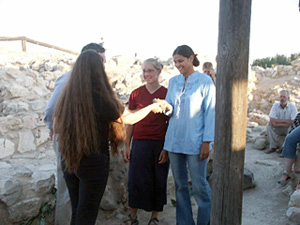 |
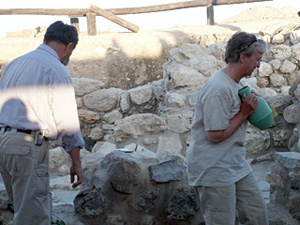 |
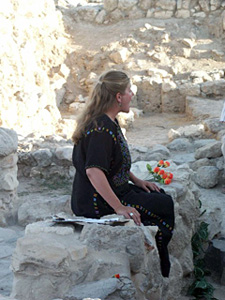 After Megan’s final song of blessing and peace upon us all, we headed up into the pines of the national park surrounding our site for a mansaf at Seven Hills Restaurant. Perched high in the Ammonite hills, we sat at long tables on the terrace with a magnificent view of the Madaba Plain stretched out at our feet. We were joined by our two representatives from the Department of Antiquities and their families, Samia Khoury and Aktham Oweidi, as well as by our head cook, Muhammad Ahmaru, our bus driver Osama, our agent Iyad Sweileh, and our travel agent Emad Salameh. It was a great time to express our thanks to everyone who helped make this season’s digging a success. So much activity goes into these six short weeks and so many people make it happen that, without them, we would get very little accomplished.
After Megan’s final song of blessing and peace upon us all, we headed up into the pines of the national park surrounding our site for a mansaf at Seven Hills Restaurant. Perched high in the Ammonite hills, we sat at long tables on the terrace with a magnificent view of the Madaba Plain stretched out at our feet. We were joined by our two representatives from the Department of Antiquities and their families, Samia Khoury and Aktham Oweidi, as well as by our head cook, Muhammad Ahmaru, our bus driver Osama, our agent Iyad Sweileh, and our travel agent Emad Salameh. It was a great time to express our thanks to everyone who helped make this season’s digging a success. So much activity goes into these six short weeks and so many people make it happen that, without them, we would get very little accomplished.
This is a new week and most of us are working at the site for a while, drawing more balks and top plans. Those of us left back in camp are  cleaning the last of the bones, sorting publishable from unpublishable pottery, photographing the last of the objects, writing press releases, and preparing things for the move to the storeroom.
cleaning the last of the bones, sorting publishable from unpublishable pottery, photographing the last of the objects, writing press releases, and preparing things for the move to the storeroom.
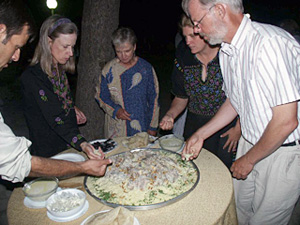
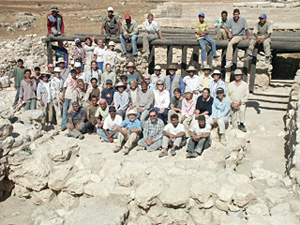 We’re nearing the end of a wonderful adventure. Some of us will come again and renew old friendships, but we will probably not see others again. We hope to stay in touch and we hope for safe traveling for everyone as they wend their way home.
We’re nearing the end of a wonderful adventure. Some of us will come again and renew old friendships, but we will probably not see others again. We hope to stay in touch and we hope for safe traveling for everyone as they wend their way home.
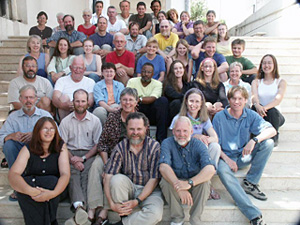 Overheard
Overheard
“I await your white end toward me.”
This comes from (choose all that apply):
- A Canadian from Alberta
- A Methodist minister, whose parish has had reason to wonder about her in the past, leaving the comforts of the Puget Sound for the accommodations of dig camp in the first place
- A bi-polar person with an “either-or” perspective
- A spectator at a fashion show
This means:
- We’ve been too long without snow.
- Tell me how to move the black and white meter stick in preparation for a photo, as in “I await your ‘White-end-toward-me’ request.”
- Don’t ride the fence. You’re either for us or against us.
- Please turn around for me.
"Archaeology is a violent sport."
Spoken by John Raab, suffering from a sciatic nerve problem which has unfortunately sidelined him for the past several days. He also thinks that our requesting for his use His Royal Majesty's airplane for a more comfortable ride home would not be asking too much -- of us or of the king. He also has stories to tell about some alternative medical treatments he received while in his present condition. He may also tell you about his present condition, if pressed, but normally he is quite modest and unassuming.
PS -- Each year MPP-`Umayri makes a contribution to the Amman Training College for the privilege of staying here and enjoying the security and pleasantly Jordanian/Palestinian ambiance of the school. When we talked with the administration about something for this year, there were two choices presented to us: 1) purchase some computers (ca. $1,000 each) for a new computer lab for students learning important skills to make it in today’s world or 2) assist with the annual costs of a new extremely high-speed line so all the campus could enjoy better internet access (ca. $2,000 per year). Our team discussed it and felt that the high-speed line would serve more people in more ways. Our annual budget for such things covered just over one year’s costs and two generous `Umayrites (Audrey Schaffer and Ruth Kent) added enough to make payments for another half year. When I gave the money to the head of the United Nations Relief and Works Agency (UNRWA) in Jordan , Daniel Deasy, he was extremely pleased, so much so that he and several of his colleagues joined us for a tour of the site on Tuesday. I promised that I would try to raise more funds from MPP and its friends. So, if you could spare some money to help complete two years of internet service, it would be much appreciated. Or, you may want to adopt a computer and purchase one of these for the lab. Many thanks. Email dcasor@bu.edu.
PSS – We close this final edition of the Weekly Reports for the 2004 season with the words of a song Megan Owens located on the internet and sang as the closing number for the Talent Show to the tune of Finlandia:
My country’s skies are bluer than the ocean,
And sunlight beams on cloverleaf and pine.
But other lands have sunshine too, and clover,
And skies are everywhere as blue as mine.
Oh hear my song, O God of all the nations,
A song of hope for their land and for mine.
This is my home, the country where my heart is.
Here lie my hopes, my dreams, my holy shrine.
But other hearts in other lands are beating
With hopes and dre
ams as true and high as mine.
This is my song, O God of all the nations,
A song of peace for their land and for mine.
We continue to hope and pray for the people of this region, especially those marginalized and dehumanized by the political vortex of violence swirling around them.
